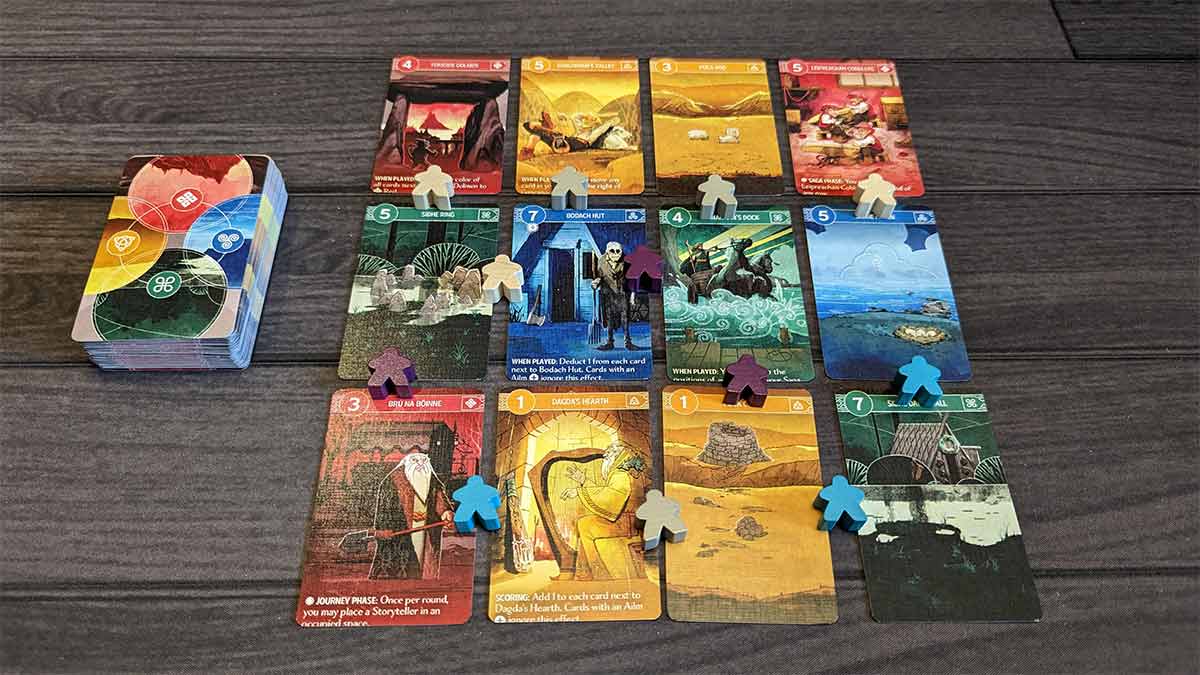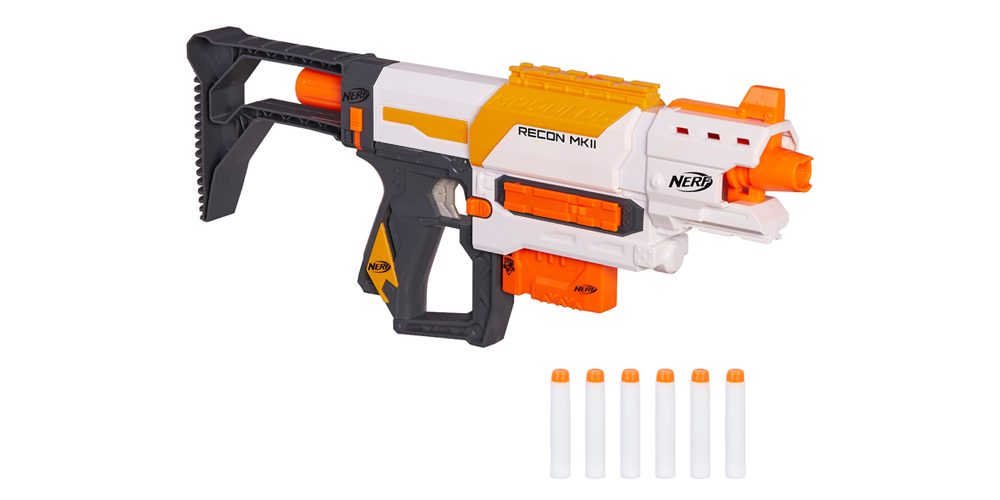The road to Tír na nÓg, the Celtic Otherworld, is open, and your storytellers have journeyed there and returned with tales of fantastic treasure, weird creatures, and more. Whose storytellers will create the best, most lasting saga?
What Is Tír na nÓg?
Tír na nÓg is a game for 1-5 players, ages 13 and up, and takes about 45 minutes to play. It’s currently seeking funding on Gamefound, with a pledge level of $36 for a copy of the game.
Tír na nÓg was designed by Isaac Shalev and Jason Slingerland and published by Grand Gamer’s Guild, with illustrations by Marlies Barends.
New to Kickstarter? Check out our crowdfunding primer.
Tír na nÓg Components
Note: My review is based on a prototype copy, so it is subject to change and may not reflect final component quality.

Inside the box, you’ll find:
- 96 encounter cards
- 30 double-sided Gaes cards, 6 each in 5 colors
- 6 “Regions of Tír na nÓg” cards
- 1 solo card
- 24 color change tokens
- 25 value tokens
- 15 storytellers, 3 each in 5 colors
- 1 first player token
- 1 score pad
The main components in the prototype I was sent that appear to be close to their finished appearance are the cards. The Encounter cards are standard poker-sized cards. Most feature some kind of fantasy artwork and a value in the top left corner. Some feature ability text as well.

The artwork on the cards is all very good, and I particularly like how they are almost entirely the color they represent. All too often, game designers feature full-color artwork and maybe a border to denote the color, but here, they remembered that the color is what matters, and made sure there’s no mistaking it.
(As you’ll see in some of my pictures, the ability text on some of the cards is cut off at the bottom, but that is merely an artifact of the prototype. I have played enough finished games from Grand Gamer’s Guild that I know the final product will not have an issue like that.)

The Gaes cards also appear to be in a near-finished state. They are simple and to-the-point, which again, I like. They show on the left a diagram of how they will score, and on the right, a text description of the same. No wasted flair or unneeded art here, and so they’re very easy to use. I should note that the only difference between them is the color–the top, middle, and bottom row scoring is the same for all players.

The color change and value tokens will presumably look something like the prototypes–small round cardboard discs. The colors are double-sided but the same front-and-back, with the color and that color’s symbol, both of which are represented on the cards. These are used whenever a card effect changes either its color or another card’s color, and are invaluable for remembering that the change happened, thereby reducing the possibility of misscoring a changed card.

There is one value token with “high” and “low” on the two sides, and the rest have two different (and seemingly random) numbers, from 0 to 12. They serve the same purpose (and are the same nice addition to the game) as the color change tokens.

The storytellers in the prototype are standard meeples, but from the rules its clear that the finished game will have custom shapes as well as colors, with different related symbols on them. I can’t wait to see what those look like.
The prototype didn’t include a representation of the first player token or the scorepad, and the rules don’t have pictures of those yet either, but again, I have played enough other titles from this publisher that I’m confident they’ll be great.
How to Play Tír na nÓg
The Goal
The goal of the game is score the most points by creating sagas that match the scoring options on the Gaes cards.
Setup
Each player takes the storytellers, Gaes cards, and Regions of Tír na nÓg cards of their color. They set the Regions card in front of them on the side with the appropriate player count, and then set up their Saga by placing the bottom, middle, and top Gaes cards in that order. Players collectively decide which side of the Gaes cards to use in the game, although one side is marked “1st” as the suggested side for the initial game.

Then, the encounter cards are shuffled and 5 are dealt to each player. From the remaining cards, an Otherworld grid is set up, based on the player count: a 3×4 grid for 3 players, a 3×5 grid for 4, and a 3×6 for 5. For 2 players, create a 3×3 grid, but leave out the center card. The leftover cards are placed in a face-down deck.
The first player token is given to whomever most recently told a story.
Gameplay
The game is played over five rounds. Each round consists of three phases.
In the Journey phase, players place their storytellers. In turn order, starting with the first player and working clockwise, each player places one storyteller in the Otherworld.

Placement rules for the storyteller require that it be placed in the junction between two of the cards in the grid. Storytellers may not be placed in the corner junction between four cards, may not be placed on the edge of the grid (this includes the inside edge with the two-player grid), and may not be placed where another storyteller has already been placed.
This storyteller placement is the key strategic decision in the game, and the cards you are able to draw are dictated by this placement. So you have to plan ahead and make sure you place your storytellers on the cards you want. But at the same time, you aren’t guaranteed to get the card, as another player may also have a storyteller there, and may draw the card before you do.
Once all of the storytellers are placed, you proceed to the Saga phase. Here, the turn order reverses, to the player to the starting player’s right–the person who placed the last storyteller–goes first, and then play continues counter-clockwise. The first player, therefore, has the best opportunity to place storytellers, but gets the worst draw.
Players may pick up either of the two encounter cards any of their storytellers are touching. They can pick up a card even if it would “strand” another storyteller (even their own) so that that storyteller is no longer touching any card. They place the drawn card in their hand, and the storyteller back in their supply.

Then, they place a card in their Saga. The card they place may either be the card they just picked up, or any other card from their hand. This card is placed next to one of their Gaes cards. Players will be creating a grid to the right of their Gaes cards. Generally, they need to place a card either directly to the right of on of their Gaes cards, or to the right of an existing card in the Saga. However, there may be cards in play that chance this, and allow players to place cards in non-standard locations.
Players may not move any card they have player after the fact… unless they play a card that allows that.
Once a player has completely both of these steps–drawing a card from the Otherworld, and then playing a card to their Saga, play passes to the player on their right, and continues around the table counter-clockwise until there are no more cards next to storytellers.

As mentioned earlier, it is legal to pick up a card that would “strand” a storyteller so that it no longer touches any card. If a player has only these “lost” storytellers, their turn is skipped in the Saga phase until everyone else has drawn everything they can. Then, in the same turn order, players with these stranded storytellers must draw one of the remaining cards in the grid, although they are allowed to draw whichever one they choose. However, if a player has more than one lost storyteller, they only get to draw one additional card, which means that they will end up with fewer cards in their Saga overall (and thus, the ability to gain fewer points overall).
After all of the storytellers have been picked up, move to the final phase—Cleanup. All players discard one card from their hand, so that they will now have a number of cards in their hand equal to the number of rounds left in the game. Then, assuming players have cards left (if they don’t, the fifth round has ended, and the game is over) all remaining cards in the Otherworld are discarded, and a new grid is created. The first player token moves to the left, and a new round begins.
Game End

The game ends at the end of the fifth round. Players proceed to final scoring. Most players will have 15 cards in their Saga, divided into three rows of 5. However, it’s possible that a player could have had multiple “lost” storytellers in a round, and thus will have fewer than 15 cards. Some card effects also might have allowed a player to move cards around, so their 15 cards might not be in three even rows.
To score, players first check their encounter cards and see if any of those trigger effects in final scoring; if they do, they score first.
Then, each player scores based on their Gaes cards. Most cards score based on their value–the number in the top left corner–although some scoring may require adding the values of multiple cards.
Once that scoring is complete, all players score the Regions of Tír na nÓg cards. First, every player totals the size of their regions of each color–the total number of orthogonally-adjacent cards. The player with the biggest region (most cards) of each color scores for that, based on the Region card in play, as does the player with the second-biggest region. Only regions with 2 or more cards count. In the case of a tie, each player gets half the points (rounded down) for the tied position, but if the tie is for the biggest region, then the second-biggest doesn’t score at all.
The player with the most points win. If there’s a tie, with the player with the biggest single region wins.
Why You Should Play Tír na nÓg
Tír na nÓg is one of those games that looks deceptively simple on the outside but turns out to have multiple depths of strategy available.
At the outset, it looks like a game where you are in essence drafting a card from a grid and then placing it to solve a puzzle. And if you have to give an overly simplified description of the game, that’d be it.
But right at the start you realize that the placement of the storytellers, along with the reverse turn order, makes that drafting deviously challenging. If there’s a card you really need, you might get lucky–maybe it’s a corner card, and your opponents won’t recognize that you really need it, and you can place two of your storytellers on it (one on each of the two sides that connect it to the grid), thus guaranteeing that you get it. But if the card is in the middle of the grid, that becomes impossible (you only have 3 storytellers, and a card could be connected on all four sides). Also, that card you need might also be needed by another player, in which case your seating order, which you probably weren’t considering when you sat down, becomes critical.
In any drafting game, hate-drafting is a possibility, but in Tír na nÓg, there are two distinct ways to do it. You can simply choose to draw a card from the Otherworld that you know an opponent needs (assuming that you placed a storyteller there and were ahead of them in the reverse turn order), but unlike in many other games, you aren’t necessarily pulling a card that you have to use that might not be helpful. Because you can place a card to your Saga from your hand, there’s really very little penalty to picking up a card you know you’ll never use (except, of course, the penalty that it means not drawing a card you might want). This is even more true when you realize that you do get to simply discard a card at the end of each round.
The second “gotcha” component is in drawing a card specifically to strand one of your opponent’s storytellers. If it’s the only one that gets stranded, they’ll still get a card for it–although it will be definition be one they were less interested in (otherwise, they would have presumably put on storyteller on that card), but it might also really, genuinely screw them, as if it’s a second stranded storyteller, they won’t get a card for it at all.
Once you’ve drafted, there’s the puzzle-solving element. Where do you place your card in the Saga to its maximum benefit? This is a very challenging part of the game, but if you like puzzle games, you’ll love this element, which has a lot of “well, if I place this here, it’ll score nicely for this row, but mess up my region”-type decisions. And then there are the cards with the special abilities to factor in.
We had a great time playing Tír na nÓg. The combination of strategic and tactical decisions is great. The the game combines elements of worker placement, drafting, and puzzle solving in some truly unique ways, and it has just the right amount of player interaction to keep things interesting.
I for one can’t wait to see what the final game looks like, but I suspect it’s one that will find its way to the table on a regular basis.
For more information or to make a pledge, visit the Tír na nÓg Gamefound page!
Click here to see all our tabletop game reviews.
![]() To subscribe to GeekDad’s tabletop gaming coverage, please copy this link and add it to your RSS reader.
To subscribe to GeekDad’s tabletop gaming coverage, please copy this link and add it to your RSS reader.
Disclosure: GeekDad received a copy of this game for review purposes.





